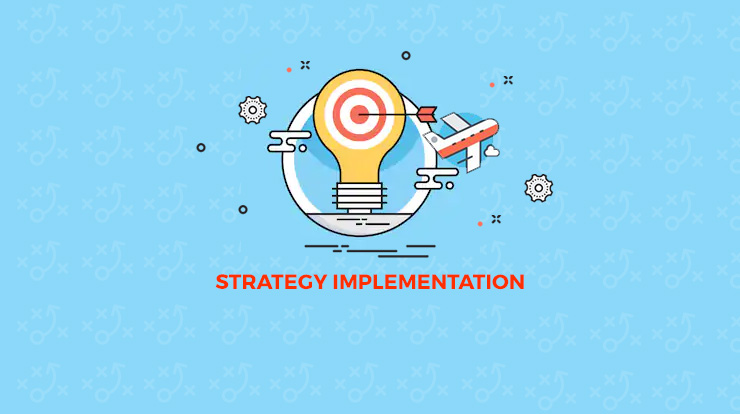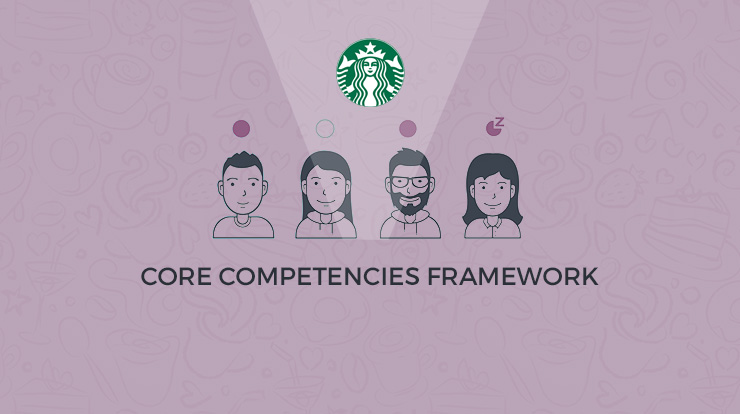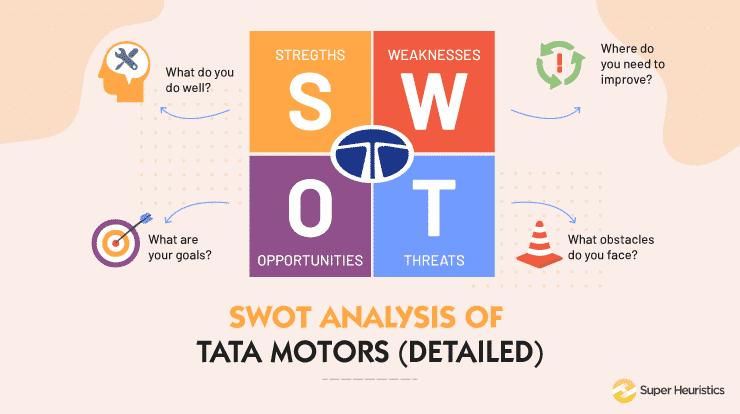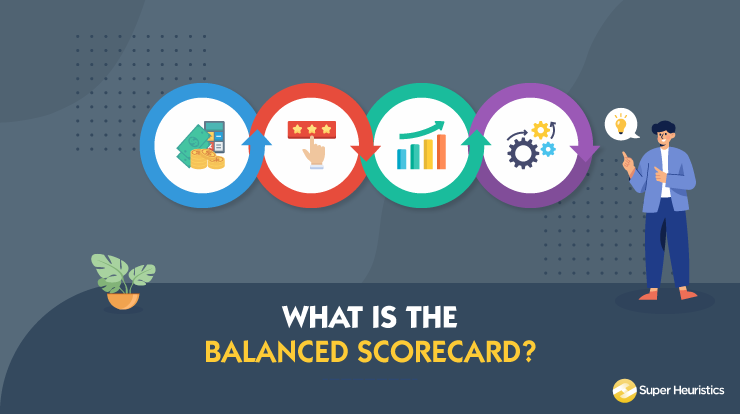
It’s a great saying in business management by Peter Drucker “Anything which cannot be Measured, cannot be Managed”.
If I tell you this particular firm’s performance is good, will you take my word for it? The answer is No, you will go ahead and ask me what makes you think so. Give me some concrete data to validate it.
Will you buy my point if I say their financials are really good, even though they lack in customer satisfaction aspect? You will say No again.
So, where is the right balance of all the aspects and How to measure them for the firm where every minute hundreds of operations are performed by thousands of employees?
The answer to your question lies in another question- What is a balanced scorecard?
Let’s find out.
Why We Need a Balanced Scorecard?
If I tell you that the new strategy you have come up for the supply chain management is a hit. Your next question will be-how, can you say so?
The answer to this question is very simple- Measurement. Let’s come back to my early statement, the new strategy for the supply chain operations is a hit, in order to understand this, we need to first understand- What is Supply Chain Management and What says that it’s a hit or a miss!
It is important for us to talk about the definition of Balanced Scorecard Approach here. It helps us to measure performance at all eight levels in a supply chain and measures the performance using metrics. Let’s find it out in detail and I will start by elaborating on the Supply Chain.
This knowledge of both will help us understand, why we need and what is a balanced scorecard?
First, let’s talk about Supply Chain Management.
Supply Chain Management
It would not be wrong on my part to say Supply Chain is the movement of products and services from a company to consumer and information from consumer to the company. You might agree with me, yeah, it’s so simple, and we get it, but why companies are crazy over its supply chain management?

Source: today.com
A supply chain if properly utilized, can either make or break an organization. I am not over-exaggerating this fact when I say Gap a well-established player failed in retail clothing due to its misadventures within its supply chain. On the other hand, Zara is growing by leaps and profits due to its efficient supply chain management.
Read more on Gap here
Read more on Zara here
So, any Supply chain management has several components, each one has to play its part and be interconnected with every other part to gain a competitive advantage. The components are:
- Consumer Service Management
- Consumer Relationship Management
- Demand Management
- Order Fulfilment
- Manufacturing flow Management
- Supplier Relationship Management
- Product development and Commercialization
- Returns Management
As the names suggest, we can see that the first three components and Returns Management directly engage with the consumer, so as to engage with them, gain insights for what they want and how they want it.
The rest of the components is what goes on in the backhand of a company to ensure that the consumer is getting what they want. It involves engaging with suppliers, employees, perfecting the flow of upstream and downstream of products.
You must have a brief idea by now, what is Supply Chain Management, and why is it so important for companies.
What are these metrics our next objective is to understand- What are we Measuring?
Supply Chain Performance Measurement
By now, we are clear on the fact that Supply Chain management if done efficiently provides a competitive advantage to the firm. So, in order to measure its performance, we need to focus on every aspect of the supply chain.
This seems simple right-we have eight components; we can ascertain whether each component is working fine or not. The reality is far from this if we take one component independently, we cannot measure its effect on other components, and this causes discrepancies.
The next thing you will be asking is- Now, the process seems so complex, isn’t performance measurement a cumbersome process?

Source: quanticmind.com
The answer is No. The managers focus on the primary goals of the organizations and relate it to the Supply chain. The managers use Metrics, which are a standard measure that can be used to measure performance, repeatedly. These metrics form the basics of Balanced Scorecard.
Commonly used Metrics could be-customer satisfaction ratings, orders picked from the warehouse per hour or the ratio of the operating assets to income. These metrics vary from company to company, but all good metrics should have these five characteristics:
- Metric must create an understanding of strategic objectives and tactical plans
- It must promote behaviours that are consistent with achieving these objectives
- It must allow for the recording of actual outcomes so that the firm can monitor the progress of attainment of these objectives
- It must allow companies to measure their own performance to competitors and consumer expectations
- It must motivate continuous improvement
With the basic understanding of the supply chain and the measurement process, its time, we talk about one such measurement approach and answer the question why you all are here-What is a Balanced Scorecard Approach.
In the subsequent sections, we will come to know more about What is a Balanced Scorecard, how to create a balanced scorecard and how to implement Balanced Scorecard.
What is a Balanced Scorecard Approach?
As we know by now, a supply chain measurement must address both chain evaluation and all of the other processes occurring in the firm. We also know that the process is complex, and managers use Metrics to measure this.
Some of us might have a question- Is there any systematic and definite way to measure this?
The answer to this lies in the Balanced Scorecard approach, it was invented by Robert S. Kaplan and David P Norton of the Harvard Business School. Exactly What is a balanced scorecard- It combines multiple different categories of measurements that can be used at all levels of the supply chain.
Let’s have a look at What is a balanced scorecard pictorially:
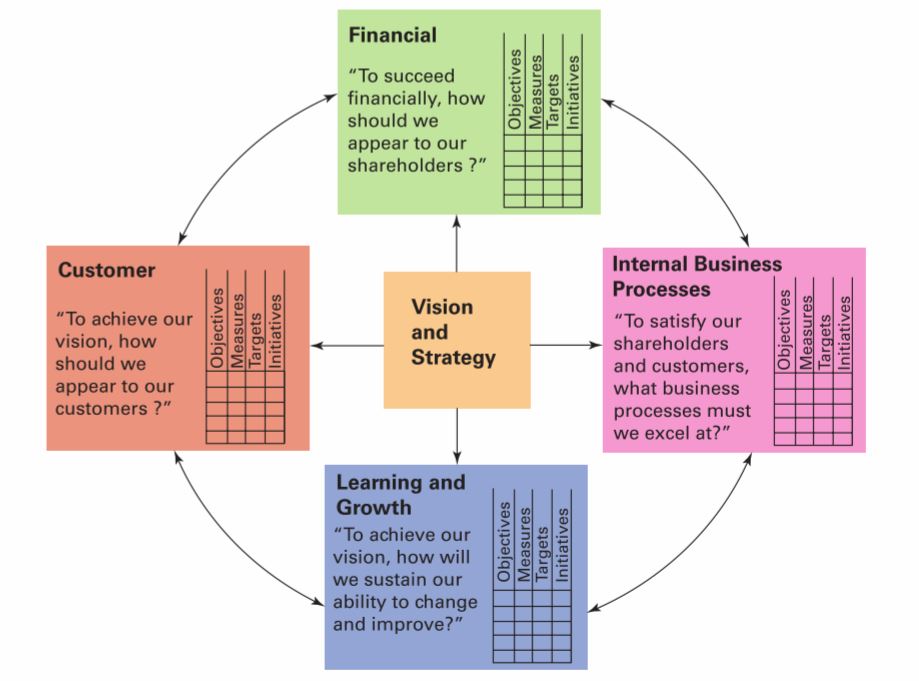
Source: balancedscorecard.org
We can see clearly that there are four aspects of the balanced scorecard. Let’s first answer this- What are the four perspectives of the balanced scorecard?
The balanced scorecard approach contains four different metrics or the four perspectives as we see. These are used to measure performance at all the levels in the supply chain. These four metrics combines the strategy and vision for every aspect of the supply chain.
The four metrics are given below, and firms always question themselves the following before proceeding ahead:
- Financial: To succeed financially, how should firms appear to their shareholders.
- Customer: To achieve our vision, how should firms appear to their customers.
- Internal Business Processes: To satisfy their shareholders and customers, what business processes firms must excel at.
- Learning and Growing: To achieve their vision, how will firms sustain their ability to change and improve.
See, these four metrics fulfil our condition for a metric, and they can well measure a firm’s supply chain at all levels.
Our basic understanding of a balanced scorecard is complete here, and it’s time to move onto how to create a balanced scorecard and also create a balanced scorecard on our own.
Also Read: How to Create a Marketing Plan: The Strategy
How to Create a Balanced Scorecard?
If one is interested to know about the performance in one of those eight aspects of Supply Chain Management, then using a balanced scorecard is a great way to achieve what one desire.
As we have looked at What is a balanced scorecard pictorially, its time to look at how to actually measure these metrics using- Objectives, Measures, Initiatives and Targets.
As is obvious the targets vary with different firms and are at the manager’s discretion, but it is always important for managers to have realistic and attainable targets, which can be based on their past performance or future goals.
Let’s look at the other parameters which are used generally by firms:
Perspectives | Goals | Objectives | Measurements |
Customer | Continuously improve customer satisfaction | Decrease lead time | Average lead time |
Increase on-time delivery | Percentage of deliveries on time | ||
Reduce customer complaints | Number of customer complaints | ||
Internal Business | Continuously improve business processes | Decrease cycle time | Average cycle time |
Increase quality | Number of defects and the number of items reworked. | ||
Increase productivity | Average output per employee | ||
Innovation & Learning | Continuously develop and deliver new innovative products & services | Increase sales of new products and services | Percentage of sales obtained from new products & services |
Reduce development time | Average time from initial design to production | ||
Financial | Continuously improve financial performance | Decrease costs | Average unit costs |
Increase sales growth | The growth rate in sales | ||
Increase market share | Company’s market share | ||
Increase return on investment | Return on investment |
As seen, here in customer metric, the objective is to decrease lead time, the managers would be measuring their average lead time and will work with a set target in mind.
Let’s say the manager wants to decrease the lead time from 30 minutes to 20 minutes in a garment factory, the managers and workers will work on a solution to decrease the lead time and can use the future data to measure how far or ahead are they of their target.
Similarly, other parameters can also be understood here.
I always believed that marketing is an applied science, so now look at some Balanced Scorecard examples to make sure we all understand how to create a balanced scorecard and become an expert in answering the question- What is a balanced scorecard.
Balanced Scorecard Examples
Understanding through examples serves the purpose of retaining the information really well, so now we will look at our example here.
The given example is a sample of a Government which is planning to be a world-class model for a successful urban community. The government’s key objectives are to give ethical and transparent governance, maintain safe and thriving communities, safe, secure and clean city which offers abundant opportunities at socio-economic levels.
The government has created a balanced scorecard to achieve its targets. Let’s have a look at them.
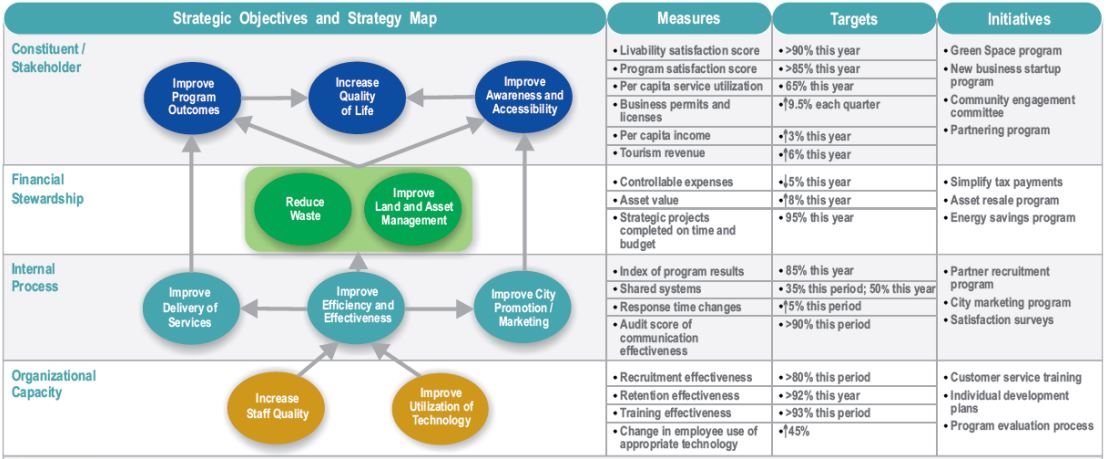
Source: balancedscorecard.org
As seen, the government has identified four metrics: Stakeholders (Customer), Financials, Internal Process and Organisational Capacity (Learning and Growing).
These metrics have their own objectives, measures, targets and initiatives.
As seen, to Increase quality of life, the government uses the measure of per capita income and wants to have a three percent rise this year. To achieve this, the government has launched an initiative to have a green space program, new business start-up program, community engagement committee and partnering program.
Similarly, we can visualize other parameters here as well.
It’s time for you to take out a pen and paper and start noting down the different aspects on a firm’s supply chain level and start creating a balanced scorecard of your own.
After knowing the answer to What is a Balanced scorecard and how to create it, it’s time to understand the importance of balanced scorecard and answer another important question- How to implement Balanced Scorecard?
Let’s find out in the upcoming section.
How to Implement a Balanced Scorecard?
The most important question is always What to do with the balanced scorecard? How to implement a balanced scorecard?
The answer to this question lies in What we actually get out of a Balanced Scorecard.
A balanced scorecard will help you and the firms to gain different types of feedback related to their supply chain operations including strategic data for high-level decision-makers, diagnostic feedback to guide process improvement, knowledge of trends in metrics over time, feedback on the effectiveness of the performance measurements themselves, and data which will be used for forecasting future business activities.
An organization more or less has tiers, and so does their supply chain. At each tier of the supply chain, the balanced scorecard addresses the four metrics: Financial, Customer, Internal Process and Learning and Growth.
Firms take repeated measurements in each of these categories and then alternate through a system whereby they focus on weak performance and improve the performance. Then they finally check the results after implementation and act again based on new measurements.
You can watch this video to gain more insights-
Conclusion
In this article, we all learned in great detail –
- What is a balanced scorecard, which combines multiple different categories of measurements that can be used at all levels of the supply chain?
- It has four main metrics-Financial, Customer, Internal Process and Learning and Growth.
- These metrics again contains four different aspects- Objectives, Measures, Initiatives and Targets. The measurement of all these helps the managers to measure all the aspects in a supply chain collectively in a systematic manner.
- The firms take repeated measurements in all these categories, check performances using the set target, and if one or more aspects aren’t working fine, they take more initiatives and again measure the performance.
So, next time you think about measuring any sort of performance, remember you have a balanced scorecard to help you out.

